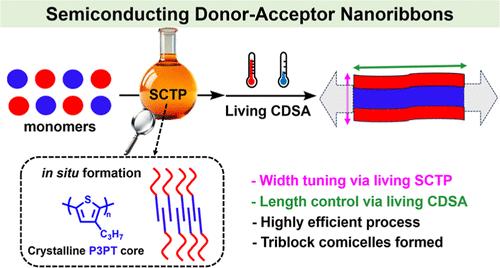当前位置:
X-MOL 学术
›
J. Am. Chem. Soc.
›
论文详情
Our official English website, www.x-mol.net, welcomes your feedback! (Note: you will need to create a separate account there.)
Highly Efficient Preparation of Length and Width-Controllable Donor–Acceptor Nanoribbons via Polymerization-Induced Crystallization-Driven Self-Assembly of Fully Conjugated Block Copolymers
Journal of the American Chemical Society ( IF 14.4 ) Pub Date : 2024-07-20 , DOI: 10.1021/jacs.4c04039 Hwangseok Kim 1, 2 , Jaeho Lee 2 , Soon-Hyeok Hwang 2 , Namkyu Yun 1 , Songyee Park 1 , Tae-Lim Choi 1
Journal of the American Chemical Society ( IF 14.4 ) Pub Date : 2024-07-20 , DOI: 10.1021/jacs.4c04039 Hwangseok Kim 1, 2 , Jaeho Lee 2 , Soon-Hyeok Hwang 2 , Namkyu Yun 1 , Songyee Park 1 , Tae-Lim Choi 1
Affiliation

|
Despite the high potential of one-dimensional (1D) donor–acceptor (D–A) coaxial nanostructures in bulk-heterojunction solar cell applications, the preparation of such 1D nanostructures using π-conjugated polymers has remained elusive. Herein, we demonstrate the first example of D–A semiconducting nanoribbons based on fully conjugated block copolymers (BCPs) prepared in a highly efficient procedure with controllable width and length via living crystallization-driven self-assembly (CDSA). Initially, Suzuki–Miyaura catalyst-transfer polymerization was employed to successfully synthesize BCPs containing two types of acceptor shells as the first block, followed by a donor poly(3-propylthiophene) core as the second block. The limited solubility and high crystallinity of the core induced a polymerization-induced crystallization-driven self-assembly (PI-CDSA) of the BCPs into nanoribbons during polymerization, providing a tunable width (7.6–39.6 nm) depending on the length of the polymer backbone. Surprisingly, purifying as-synthesized BCPs via simple precipitation directly yielded short and uniform seed structures, greatly shortening the overall protocol by eliminating the time-consuming process of initial aging and breaking down to the seed required for the conventional CDSA. With this new highly efficient method, we achieved length control over a broad range from 169 to 2210 nm, with high precision (Lw/Ln < 1.20). Furthermore, combining self-seeding and seeded growth from two different D–A-type BCPs enabled continuous living epitaxial growth from each end of the nanoribbons, resulting in B-A-B triblock D–A semiconducting comicelles with controlled length.
中文翻译:

通过聚合诱导结晶驱动的全共轭嵌段共聚物自组装高效制备长度和宽度可控的供体-受体纳米带
尽管一维(1D)供体-受体(D-A)同轴纳米结构在体异质结太阳能电池应用中具有很高的潜力,但使用π共轭聚合物制备这种一维纳米结构仍然难以实现。在此,我们展示了基于完全共轭嵌段共聚物(BCP)的 D-A 半导体纳米带的第一个例子,该纳米带通过活性结晶驱动自组装(CDSA)以高效程序制备,宽度和长度可控。最初,铃木-宫浦催化剂转移聚合成功地合成了含有两种受体壳作为第一嵌段,然后是供体聚(3-丙基噻吩)核作为第二嵌段的BCP。核心的有限溶解度和高结晶度在聚合过程中诱导 BCP 发生聚合诱导的结晶驱动自组装 (PI-CDSA) 形成纳米带,从而根据聚合物的长度提供可调宽度 (7.6–39.6 nm)骨干。令人惊讶的是,通过简单的沉淀纯化合成的 BCP 直接产生了短而均匀的种子结构,通过消除传统 CDSA 所需的初始老化和分解为种子的耗时过程,大大缩短了整个方案。通过这种新的高效方法,我们实现了 169 至 2210 nm 范围内的高精度长度控制 (L w /L n < 1.20)。此外,将两种不同的 D-A 型 BCP 的自种晶和晶种生长相结合,可以从纳米带的每一端连续进行活体外延生长,从而产生长度受控的 B-A-B 三嵌段 D-A 半导体胶束。
更新日期:2024-07-23
中文翻译:

通过聚合诱导结晶驱动的全共轭嵌段共聚物自组装高效制备长度和宽度可控的供体-受体纳米带
尽管一维(1D)供体-受体(D-A)同轴纳米结构在体异质结太阳能电池应用中具有很高的潜力,但使用π共轭聚合物制备这种一维纳米结构仍然难以实现。在此,我们展示了基于完全共轭嵌段共聚物(BCP)的 D-A 半导体纳米带的第一个例子,该纳米带通过活性结晶驱动自组装(CDSA)以高效程序制备,宽度和长度可控。最初,铃木-宫浦催化剂转移聚合成功地合成了含有两种受体壳作为第一嵌段,然后是供体聚(3-丙基噻吩)核作为第二嵌段的BCP。核心的有限溶解度和高结晶度在聚合过程中诱导 BCP 发生聚合诱导的结晶驱动自组装 (PI-CDSA) 形成纳米带,从而根据聚合物的长度提供可调宽度 (7.6–39.6 nm)骨干。令人惊讶的是,通过简单的沉淀纯化合成的 BCP 直接产生了短而均匀的种子结构,通过消除传统 CDSA 所需的初始老化和分解为种子的耗时过程,大大缩短了整个方案。通过这种新的高效方法,我们实现了 169 至 2210 nm 范围内的高精度长度控制 (L w /L n < 1.20)。此外,将两种不同的 D-A 型 BCP 的自种晶和晶种生长相结合,可以从纳米带的每一端连续进行活体外延生长,从而产生长度受控的 B-A-B 三嵌段 D-A 半导体胶束。












































 京公网安备 11010802027423号
京公网安备 11010802027423号